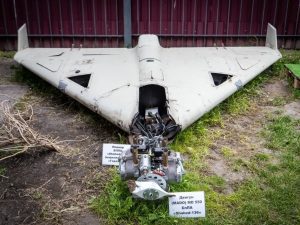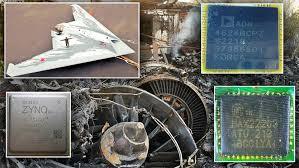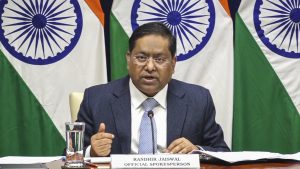New Delhi – A significant diplomatic controversy has erupted as Ukraine on Russian Drones investigations reveal that electronic components manufactured or assembled by Indian firms have been discovered in Iranian-designed drones used by Russian forces. This discovery has prompted formal diplomatic correspondence and international scrutiny of supply chain vulnerabilities in dual-use technology exports.
Formal Diplomatic Correspondence Initiated

Ukrainian authorities have taken the unprecedented step of formally raising the Ukraine on Russian Drones component issue with both the Indian government and the European Union. Through official diplomatic channels, Ukraine has communicated with India’s External Affairs Ministry on at least two separate occasions since discovering these components in Shahed 136 unmanned combat aerial vehicles.
The Ukraine on Russian Drones diplomatic correspondence represents a serious escalation in international concerns about component diversion. Ukrainian officials have provided detailed documentation and evidence to support their claims about Indian-origin electronic parts being utilized in Russian military operations against Ukrainian targets.
Also Read: “Financing War In Ukraine”: Bold Claim By Trump Aide On India Russia Oil Deal
EU Sanctions Envoy Briefed on Component Discovery


During EU sanctions envoy David O’Sullivan’s mid-July visit to New Delhi, Ukrainian diplomats specifically highlighted the Ukraine on Russian Drones component concerns. O’Sullivan’s visit focused on briefing Indian officials about the EU’s latest sanctions package, which included listing the Vadinar refinery and implementing import bans on refined products made from Russian crude.
The timing of raising Ukraine on Russian Drones issues during this high-level diplomatic visit underscores the seriousness with which Ukrainian authorities view this matter. The convergence of sanctions discussions and component diversion concerns demonstrates the interconnected nature of modern economic warfare and supply chain security.
Detailed Investigation Findings Revealed
Ukrainian authorities’ comprehensive investigation into Ukraine on Russian Drones has established specific evidence of Indian-origin components in Shahed 136 production. The investigation identified electronic components from Vishay Intertechnology and Aura Semiconductor as being integral to the drone’s operational systems.
According to the Ukraine on Russian Drones investigation documents, a “bridge rectifier E300359” from Vishay Intertechnology assembled in India was used in the Shahed’s voltage regulator unit. Additionally, a PLL-based signal generator AU5426A chip manufactured by Aura Semiconductor was incorporated into the jammer-proof antenna for the drone’s satellite navigation system.
Technical Components Enable Drone Capabilities


The Ukraine on Russian Drones findings reveal how seemingly routine electronic components can become critical military capabilities. The bridge rectifier component supports the drone’s power management systems, while the signal generator chip enhances the drone’s navigation resilience against electronic warfare countermeasures.
These technical discoveries in the Ukraine on Russian Drones investigation demonstrate the sophisticated integration of commercial-off-the-shelf components into military platforms. The dual-use nature of these components makes tracking their ultimate destination particularly challenging for export control authorities.
Indian Legal Compliance and Regulatory Framework
Despite the Ukraine on Russian Drones component discoveries, technical assessments indicate that the involved firms have not violated any Indian laws. External Affairs Ministry spokesperson Randhir Jaiswal emphasized that India’s dual-use item exports comply with international non-proliferation obligations and domestic legal frameworks.


The Ukraine on Russian Drones situation highlights the complexity of export control compliance when components can be legally exported to legitimate destinations before being diverted through unauthorized channels. Indian authorities maintain that due diligence procedures are conducted to ensure exports don’t violate applicable laws.
Corporate Responses to Component Diversion
Aura Semiconductor has issued a comprehensive statement regarding the Ukraine on Russian Drones component discovery, expressing deep concern about potential unauthorized third-party diversion. The Bengaluru-based firm emphasized its commitment to lawful and ethical product use while fully complying with national and international export control regulations.
The company’s response to the Ukraine on Russian Drones revelations included conducting a limited audit to understand end-use scenarios. However, the audit findings were inconclusive regarding supply chain visibility, as the “plug-and-play” nature of the components makes end-user tracing extremely difficult.
Supply Chain Diversion Challenges
The Ukraine on Russian Drones investigation has revealed instances of electronic components being legally exported from India to West Asian destinations before being diverted to Russia or Iran. This pattern demonstrates the sophisticated nature of component procurement networks that exploit legitimate trade channels.
Following the Ukraine on Russian Drones diplomatic communications, Indian security agencies have conducted visits to electronic component manufacturers in Delhi, Bengaluru, and Mumbai. These visits aimed to sensitize manufacturers about international restrictions related to dual-use items and potential diversion risks.
Shahed Drone Operational Impact


The Ukraine on Russian Drones component investigation focuses on the Shahed 136, a relatively inexpensive drone that Russia has deployed extensively against Ukrainian targets since late 2022. According to Ukrainian Security Service data, Iran initially supplied 2,000 fully assembled drones before Russia established its own assembly capabilities using Iranian components.
Recent Ukraine on Russian Drones operational data shows the significant scale of these attacks, with Ukraine’s air force recording 6,129 Shahed-type drone launches by Russia in July alone. This volume demonstrates the strategic importance of understanding and disrupting the supply chains supporting these weapons systems.
International Component Diversion Concerns
The Ukraine on Russian Drones investigation has also identified electronic components from American and Chinese firms in Russian weapons systems, indicating a broader international challenge in controlling dual-use technology transfers. This global dimension of component diversion complicates efforts to establish accountability and implement effective countermeasures.
Export Control System Limitations
Trade experts emphasize that the Ukraine on Russian Drones component diversion represents a fundamental challenge facing all open economies. Once dual-use goods are exported to legitimate third countries, tracing their ultimate end-use becomes nearly impossible, regardless of the rigor of initial export controls.
The Ukraine on Russian Drones revelations underscore the need for enhanced exporter awareness, particularly in sensitive technology sectors, while acknowledging that no system can guarantee complete control once goods leave national borders.

